Spinal stenosis is a narrowing of the spaces within your spine, which can put pressure on the nerves that travel through the spine. Spinal stenosis occurs most often in the lower back and the neck.
Some people with spinal stenosis may not have symptoms. Others may experience pain, tingling, numbness and muscle weakness. Symptoms can worsen over time.
Spinal stenosis is most commonly caused by wear-and-tear changes in the spine related to osteoarthritis. In severe cases of spinal stenosis, doctors may recommend surgery to create additional space for the spinal cord or nerves.
Types of spinal stenosis
The types of spinal stenosis are classified according to where on the spine the condition occurs. It’s possible to have more than one type. The two main types of spinal stenosis are:
• Cervical stenosis. In this condition, the narrowing occurs in the part of the spine in your neck.
• Lumbar stenosis. In this condition, the narrowing occurs in the part of the spine in your lower back. It’s the most common form of spinal stenosis.
Symptoms
Many people have evidence of spinal stenosis on an MRI or CT scan but may not have symptoms. When they do occur, they often start gradually and worsen over time. Symptoms vary depending on the location of the stenosis and which nerves are affected.
In the neck (cervical spine)
• Numbness or tingling in a hand, arm, foot or leg
• Weakness in a hand, arm, foot or leg
• Problems with walking and balance
• Neck pain
• In severe cases, bowel or bladder dysfunction (urinary urgency and incontinence)
In the lower back (lumbar spine)
• Numbness or tingling in a foot or leg
• Weakness in a foot or leg
• Pain or cramping in one or both legs when you stand for long periods of time or when you walk, which usually eases when you bend forward or sit
• Back pain
When to see a doctor
See your doctor if you have any of the symptoms listed. (Request an appointment with Dr. Lazary)
Causes
The backbone (spine) runs from your neck to your lower back. The bones of your spine form a spinal canal, which protects your spinal cord (nerves).
Some people are born with a small spinal canal. But most spinal stenosis occurs when something happens to narrow the open space within the spine. Causes of spinal stenosis may include:
• Overgrowth of bone. Wear and tear damage from osteoarthritis on your spinal bones can prompt the formation of bone spurs, which can grow into the spinal canal. Paget’s disease, a bone disease that usually affects adults, also can cause bone overgrowth in the spine.
• Herniated disks. The soft cushions that act as shock absorbers between your vertebrae tend to dry out with age. Cracks in a disk’s exterior may allow some of the soft inner material to escape and press on the spinal cord or nerves.
• Thickened ligaments. The tough cords that help hold the bones of your spine together can become stiff and thickened over time. These thickened ligaments can bulge into the spinal canal.
• Tumors. Abnormal growths can form inside the spinal cord, within the membranes that cover the spinal cord or in the space between the spinal cord and vertebrae. These are uncommon and identifiable on spine imaging with an MRI or CT.
• Spinal injuries. Car accidents and other trauma can cause dislocations or fractures of one or more vertebrae. Displaced bone from a spinal fracture may damage the contents of the spinal canal. Swelling of nearby tissue immediately after back surgery also can put pressure on the spinal cord or nerves.
Risk factors
Most people with spinal stenosis are over the age of 50. Though degenerative changes can cause spinal stenosis in younger people, other causes need to be considered. These include trauma, congenital spinal deformity such as scoliosis, and a genetic disease affecting bone and muscle development throughout the body. Spinal imaging can differentiate these causes.
Complications
Rarely, untreated severe spinal stenosis may progress and cause permanent:
• Numbness
• Weakness
• Balance problems
• Incontinence
• Paralysis
Treatment
Treatment for spinal stenosis depends on the location of the stenosis and the severity of your signs and symptoms. Surgery may be an option if other treatments haven’t helped.
The goals of surgery include relieving the pressure on your spinal cord or nerve roots by creating more space within the spinal canal. Surgery to decompress the area of stenosis is the most definitive way to try to resolve symptoms of spinal stenosis.
Research shows that spine surgeries result in fewer complications when done by highly experienced surgeons. Don’t hesitate to ask about your surgeon’s experience with spinal stenosis surgery. If you have any doubts, get a second opinion.
Examples of surgical procedures to treat spinal stenosis include:
• Decompression/Laminotomy. This procedure removes only a portion of the lamina, typically carving a hole just big enough to relieve the pressure in a particular spot.
• Laminoplasty. This procedure is performed only on the vertebrae in the neck (cervical spine). It opens up the space within the spinal canal by creating a hinge on the lamina. Metal hardware bridges the gap in the opened section of the spine.
• Fusion. If spinal stenosis is complicated with segmental instability or extended decompression leads to the instability of the segment, the stabilization (fusion) of the vertebrae is indicated.
• Minimally invasive surgery. This approach to decompression surgery removes bone or lamina in a way that reduces the damage to nearby healthy tissue. This results in less need to do fusions. Fusion procedures can be also done with one of the minimally invasive stabilization techniques. A minimally invasive approach to surgery has been shown to result in a shorter recovery time.
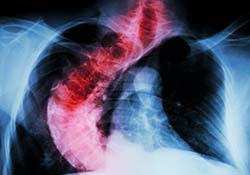
Deformity
The normal spine is structurally balanced for optimal flexibility and support of the body’s weight. When viewed from the side, it has three gentle curves. The lumbar (lower) spine has an inward curve called lordosis. The thoracic (middle) spine has an outward curve...
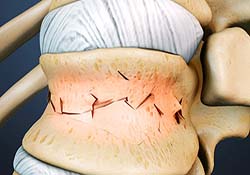
Vertebral fracture
Even minor falls or trauma can produce a spine fracture. Many of these injuries will never require surgery, but major fractures can result in serious long-term problems unless treated promptly and properly. Spine fractures range from painful compression fractures,...
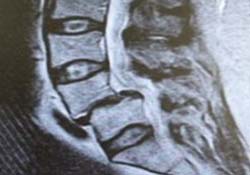
Segmental instability
Each spinal segment is like a well-tuned part of a machine. All of the parts should work together to allow weight bearing, movement, and support. A spinal segment is composed of two vertebrae attached together by ligaments, with a soft disc separating them. The facet...
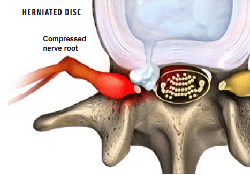
Disc herniation
A herniated disk refers to a problem with one of the rubbery cushions (disks) between the individual bones (vertebrae) that stack up to make your spine. A spinal disk is a little like a jelly donut, with a softer center encased within a tougher exterior. Sometimes...
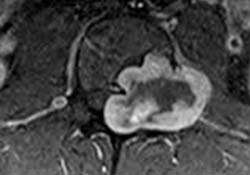
Primary spinal tumors
Primary tumors originating from the spine are very complex and challenging entities totreat. Due to their rarity, a multicenter collaborative network is essential to shepherd thebest research and contribute to the dissemination of the best evidence possible. Overthe...
